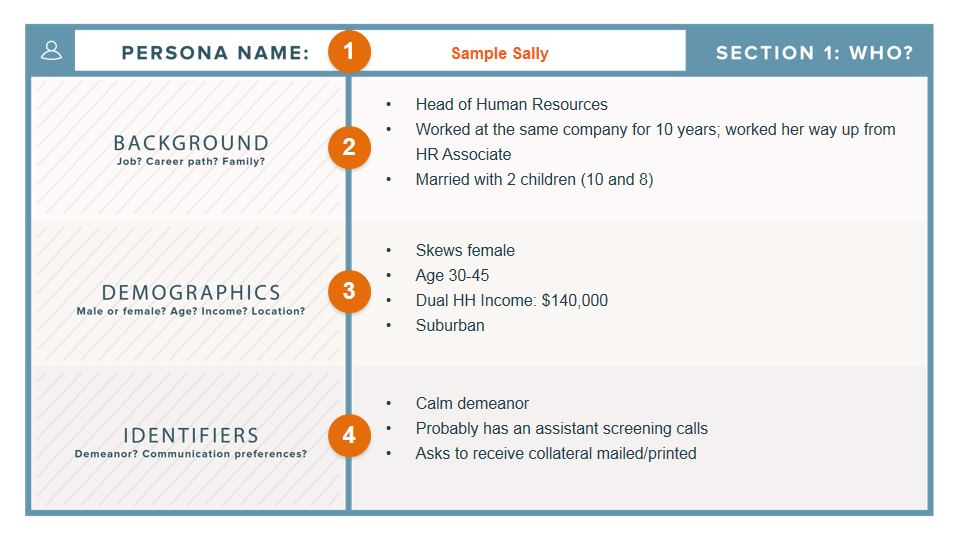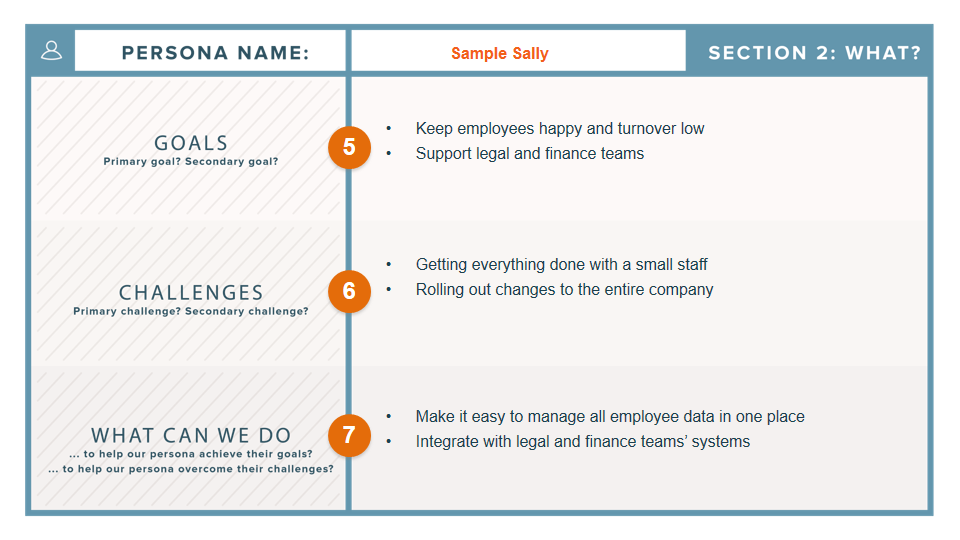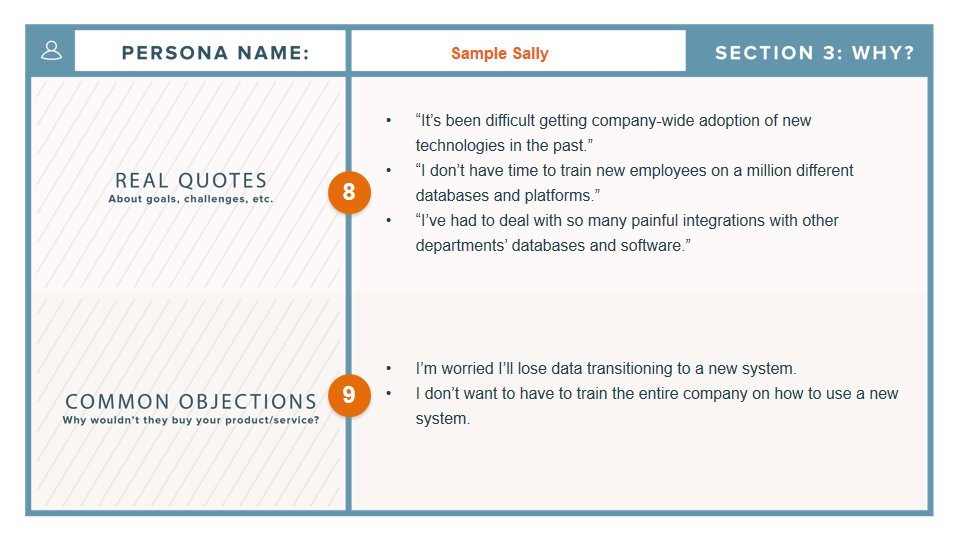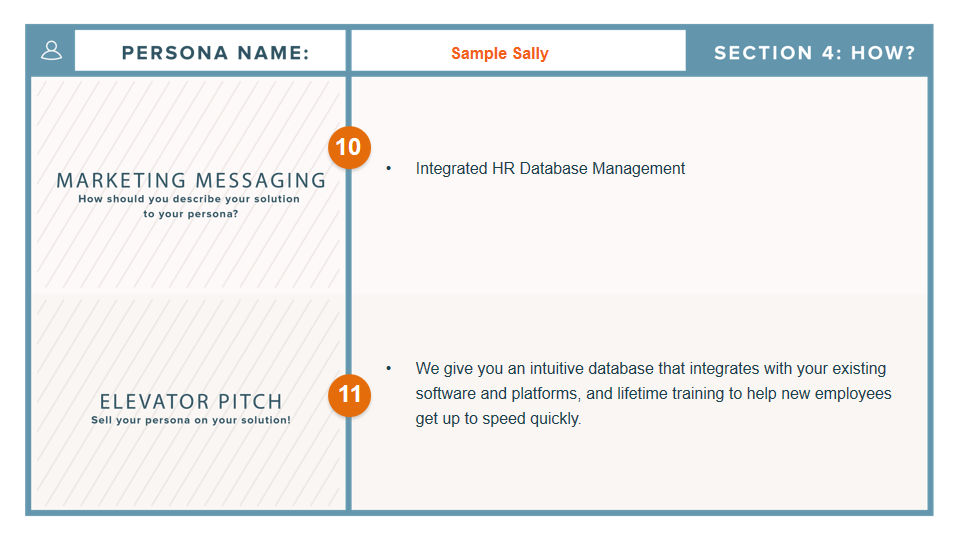Marketing Margie. Sales Sam. IT Isabel. Accounting Alan.
Do you know who your business’s buyer personas are? And if so, how much do you know about them?
Buyer personas are semi-fictional representations of your ideal customers based on data and research. They help you focus your time on qualified prospects, guide product development to suit the needs of your target customers, and align all work across your organization (from marketing to sales to service).
As a result, you’ll be able to attract high-value visitors, leads, and customers to your business who you’ll be more likely to retain over time.
More specifically, having a deep understanding of your buyer persona(s) is critical to driving content creation, product development, sales follow up, and really anything that relates to customer acquisition and retention.
“Okay, so personas are really important to my business. But … how do I actually make one?”
Ahh … the million-dollar question. The good news is, they aren’t that difficult to create. It’s all about how you obtain your market research and customer data, and then present that information within your business.
Follow along with this guide and download these persona templates to simplify this process. Before you know it, you’ll have complete, well-planned buyer personas to show off to your entire company!
Before we dive into the buyer persona-creation process, let’s pause to understand the impact of well-developed buyer personas on your business (most specifically, your marketing efforts).
Why exactly are buyer personas so important to your business?
Buyer personas help you understand your customers (and prospective customers) better. This makes it easier for you to tailor your content, messaging, product development, and services to meet the specific needs, behaviors, and concerns of the members of your target audience.
For example, you may know your target buyers are caregivers, but do you know what their specific needs and interests are? What is the typical background of your ideal buyer? In order to get a full understanding of what makes your best customers tick, it’s critical to develop detailed personas for your business.
The strongest buyer personas are based on market research as well as insights you gather from your actual customer base (through surveys, interviews, etc.).
Depending on your business, you could have as few as one or two personas, or as many as 10 or 20. But if you’re new to personas, start small — you can always develop more personas later if needed.
What about “negative” buyer personas?
While a buyer persona is a representation of your ideal customer, a negative — or “exclusionary” — persona is a representation of who you don’t want as a customer.
For example, this could include professionals who are too advanced for your product or service, students who are only engaging with your content for research/ knowledge, or potential customers who are just too expensive to acquire (because of a low average sale price, their propensity to churn, or their unlikeliness to purchase again from your company).
How can buyer personas be used in marketing?
At the most basic level, developing personas allows you to create content and messaging that appeals to your target audience. It also enables you to target or personalize your marketing for different segments of your audience.
For example, instead of sending the same lead nurturing emails to everyone in your database, you can segment by buyer persona and tailor your messaging to what you know about those different personas.
Furthermore, when combined with lifecycle stage (i.e. how far along someone is in your sales cycle), buyer personas also allow you to map out and create highly targeted content. (You can learn more about how to do that by downloading our Content Mapping Template.)
And if you take the time to also create negative personas, you’ll have the added advantage of being able to segment out the “bad apples” from the rest of your contacts, which can help you achieve a lower cost-per-lead and cost-per-customer — and, therefore, see higher sales productivity.
Different Types of Buyer Personas
While beginning work on your personas, you may ask yourself, “What are the different types of buyer personas?” From there, it’d be simple to adjust one for your business — right?
Well, that’s not exactly how it works — there isn’t a set list of universally-recognized buyer personas to choose from, nor is there a standard for the number of personas you need. This is because each business (no matter how many competitors they have) is unique — and for that reason, their buyer personas should be unique to them, too.
For these reasons, identifying and creating your different buyer personas can, at times, be slightly challenging. This is why we recommend using HubSpot’s Make My Persona generator (as well as HubSpot’s persona templates) to simplify the process of creating different personas.
In general, companies may have the same, or similar, categories for their buyer personas (e.g. a marketer, an HR rep, an IT manager, etc.). But the different personas your business has and the number of them your business requires will be tailored to who your target audience includes and what you offer your customers.
Now, are you ready to start creating your buyer personas?
How to Create Buyer Personas
Buyer personas can be created through research, surveys, and interviews — all with a mix of customers, prospects, and those outside your contacts database who might align with your target audience.
Here are some practical methods for gathering the information you need to develop personas:
-
Look through your contacts database to uncover trends about how certain leads or customers find and consume your content.
-
Use form fields that capture important persona information when creating forms to use on your website. For example, if all of your personas vary based on company size, ask each lead for information about company size on your forms.
-
Consider your sales team’s feedback on the leads they’re interacting with most. What generalizations can they make about the different types of customers you serve best?
- Interview customers and prospects to discover what they like about your product or service.
Now, how can you use the above research to create your personas?
Once you’ve gone through the research process, you’ll have a lot of meaty, raw data about your potential and current customers. But what do you do with it? How do you distill all of it so it’s easy for everyone to understand all the information you’ve gathered?
The next step is to use your research to identify patterns and commonalities from the answers to your interview questions, develop at least one primary persona, and share that persona with the rest of the company.
Use our free, downloadable persona template to organize the information you’ve gathered about your persona(s). Then share these slides with the rest of your company so everyone can benefit from the research you’ve done and develop an in-depth understanding of the person (or people) they’re targeting every day at work.
Here’s how to work through the steps involved in creating your buyer personas in more detail.
1. Fill in your persona’s basic demographic information.
Ask demographic-based questions over the phone, in person, or through online surveys. (Some people are more comfortable disclosing personal information like this.)
It’s also helpful to include some descriptive buzzwords and mannerisms of your persona that you may have picked up on during your conversations to make it easier for people on your team to identify certain personas when they’re talking to prospects.
Here’s an example of how you might complete Section 1 in your template for one of your personas:
2. Share what you’ve learned about your persona’s motivations.
This is where you’ll distill the information you learned from asking “why” during those interviews. What keeps your persona up at night? Who do they want to be? Most importantly, tie that all together by telling people how your company can help them.
3. Help your sales team prepare for conversations with your persona.
Include some real quotes from your interviews that exemplify what your personas are concerned about, who they are, and what they want. Then create a list of the objections they might raise so your sales team is prepared to address those during their conversations with prospects.
4. Craft messaging for your persona.
Tell people how to talk about your products/ services with your persona. This includes the nitty-gritty vernacular you should use, as well as a more general elevator pitch that positions your solution in a way that resonates with your persona.
This will help you ensure everyone in your company is speaking the same language when they’re having conversations with leads and customers.
Finally, make sure you give your persona a name (e.g. Finance Manager Margie, IT Ian, or Landscaper Larry) so everyone internally refers to each persona the same way, allowing for cross-team consistency.
How to Find Interviewees for Researching Buyer Personas
One of the most critical steps to establishing your buyer persona(s) is finding some people to speak with to suss out, well, who your buyer persona is.
That means you’ll have to conduct some interviews to get to know what drives your target audience. But how do you find those interviewees? There are a few sources you should tap into:
1. Use your current customers.
Your existing customer base is the perfect place to start with your interviews because they’ve already purchased your product and engaged with your company. At least some of them are likely to exemplify your target persona(s).
Don’t just talk to people who love your product and want to spend an hour gushing about you (as good as that feels). Customers who are unhappy with your product will show other patterns that will help you form a solid understanding of your personas.
For example, you might find that some of your less happy customers have bigger teams and need greater collaboration functionality from your product. Or, you may find they find your product too technical and difficult to use. In both cases, you learn something about your product and what your customers’ challenges are.
Another benefit to interviewing current customers is that you may not need to offer them an incentive (e.g. gift card) to do so. Customers often like being heard — interviewing them gives them a chance to tell you about their world, their challenges, and what they think of your product.
Customers also like to have an impact on the products they use. So, as you involve them in interviews like this, you may find they become even more loyal to your company. When you reach out to customers, be clear that your goal is to get their feedback, and that their feedback is highly-valued by your team.
2. Use your prospects.
Be sure to interview people who have not purchased your product and don’t know much about your brand, too. Your current prospects and leads are a great option here because you already have their contact information.
Use the data you do have about them (i.e. anything you’ve collected through lead generation forms or website analytics) to figure out who might fit into your target personas.
3. Use your referrals.
You’ll probably also need to rely on some referrals to talk to people who may fit into your target personas, particularly if you’re heading into new markets or don’t have any leads or customers yet.
Use your network — such as your coworkers, existing customers, social media contacts — to find people you’d like to interview and be introduced to. It may be tough to get a large volume of people this way, but you’ll likely get some very high-quality interviews out of it.
If you don’t know where to start, try searching on LinkedIn for people who may fit into your target personas and see which results have any connections in common with you. Then, reach out to your common connections for introductions.
4. Use third-party networks.
For interviewees who are completely removed from your company, there are a few third-party networks you can recruit from. Craigslist allows you to post ads for people interested in any kind of job and UserTesting.com allows you to run remote user testing (with some follow-up questions).
You’ll have less control over sessions run through UserTesting.com, but it’s a great resource for quick user testing recruiting.
Now that how to identity interviewees, let’s look at some tips for recruiting them.
Tips for Recruiting Interviewees
As you reach out to potential interviewees, here are a few ideas to improve your response rates.
1. Use incentives.
While you may not need them in all scenarios (e.g. customers who already want to talk to you), incentives give people a reason to participate in an interview if they don’t have a relationship with you. A simple gift card is an easy option.
2. Be clear that this isn’t a sales call.
This is especially important when dealing with non-customers. Be clear that you’re doing research and that you just want to learn from them. You are not getting them to commit to a one-hour sales call; you’re getting them to commit to telling you about their lives, jobs, and challenges.
3. Make it easy to say yes.
Take care of everything for your potential interviewee — suggest times but be flexible, allow them to pick a time right off the bat, and send a calendar invitation with a reminder to block off their time.
4. Decide how many people you need to interview.
Unfortunately, the answer is, it depends. Start with at least three-to-five interviews for each persona you’re creating. If you already know a lot about your persona, then that may be enough. You may need to do multiple interviews in each category of interviewees (customers, prospects, people who don’t know your company).
The rule of thumb is when you start accurately predicting what your interviewee is going to say, it’s probably time to stop. Through these interviews, you’ll naturally start to notice patterns.
Once you start expecting and predicting what your interviewee is going to say, that means you’ve interviewed enough people to find and internalize these patterns.
5. Determine which questions you’ll ask interviewees.
It’s time to conduct the interview! After the normal small talk and thank-you’s, it’s time to jump into your questions. There are several categories of questions you’ll want to ask in persona interviews to create a complete persona profile.
20 Questions to Ask in Persona Interviews
The following questions are organized into eight categories, but, feel free to customize this list and remove or add more questions that may be appropriate for your target customers.
1. Role Questions
- What is your job role? Your title?
- How is your job measured?
- What does a typical day look like?
- What skills are required to do your job?
- What knowledge and tools do you use in your job?
- Who do you report to? Who reports to you?
2. Company Questions
-
In which industry or industries does your company work?
- What is the size of your company (revenue, employees)?
3. Goal Questions
- What are you responsible for?
- What does it mean to be successful in your role?
4. Challenge Question
- What are your biggest challenges?
5. Watering Hole Questions
- How do you learn about new information for your job?
- What publications or blogs do you read?
- What associations and social networks do you participate in?
6. Personal Background Questions
- Describe your personal demographics (if possible, ask their age, whether they’re married, and if they have children).
- Describe your educational background. What level of education did you complete, which schools did you attend, and what did you study?
- Describe your career path. How did you end up where you are today?
7. Shopping Preference Questions
- How do you prefer to interact with vendors (e.g. email, phone, in person)?
- Do you use the internet to research vendors or products? If yes, how do you search for information?
- Describe a recent purchase. Why did you consider a purchase, what was the evaluation process, and how did you decide to purchase that product or service?
8. The “Why?” Question
This is the number one tip for a successful persona interview.
The follow-up question to pretty much every question in the above list should be “why?” Through these interviews, you’re trying to understand your customers’ (or potential customers’) goals, behaviors, and motivators. But keep in mind that people aren’t always great at reflecting on their behaviors to tell you what drives them at their core.
You don’t care that they measure the number of visits to their website, for example. What you care about is that they measure these visits as a way to show their higher-ups that they’re doing a good job.
Start with a simple question — for instance, “What is your biggest challenge?” Then spend a good amount of time diving deeper into that one question to learn more about that person. You learn more by asking, “why?” than more superficial questions.
Create Your Buyer Personas
Create your buyer personas to understand your target customers on a deeper level and ensure everyone on your team knows how to best target, support, and work with your customers. This will help you improve reach, boost conversions, and increase loyalty.
And if you’re a HubSpot customer, add your persona to your HubSpot Marketing Platform by following this step-by-step setup guide.
Editor’s note: This post was originally published in May 2015 and has been updated for comprehensiveness.
![]()
Original Entry: How to Create Detailed Buyer Personas for Your Business [Free Persona Template] is shared from https://blog.hubspot.com/marketing/buyer-persona-research via https://blog.hubspot.com/marketing
Check out the original post, How to Create Detailed Buyer Personas for Your Business [Free Persona Template] that is shared from https://putyourfamilyfirst.wordpress.com/2020/06/02/how-to-create-detailed-buyer-personas-for-your-business-free-persona-template/ via https://putyourfamilyfirst.wordpress.com




No comments:
Post a Comment